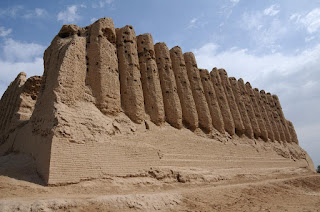 |
| Great Kyz Kala, Merv |
Merv today, in present-day Turkmenistan, is a collection of ruined cities that were continuously occupied from about 600 BC, when it was settled by Zoroastrians, to 1850 or so when it was abandoned by Turkmen.
Known as Margiana, it formed part of the empire of Alexander the Great and later the Seleucid kings. Merv reached the high point of its development in the Seljuk period, especially during the government of Sultan Sanjar (1118-1157) who made it the capital of his empire. It was a magnificent centre of science, education and culture, attracting astronomers and mathematicians such as Omar Khayyam.
It was one of the most important cities of Islam: a vibrant commercial centre with hundreds of thousands of inhabitants. Indeed, it considerably exceeded in size not only Damascus and Jerusalem, but also large cities of Western Europe of the 12th -14th centuries such as Paris, Bologna and Naples. An elaborate system of canals made life possible in Merv: the oasis was famous for its cotton plantations and orchards, while the taste of its melons was legendary.
 |
| Mausoleum of Sultan Sanjar, Merv |
In the 16th century Merv came under the domination of the Uzbek Turks and was constantly exposed to raids and annexations by rulers of neighbouring kingdoms. This lack of stability led to the relocation of the ancient West-East trade route from Merv to Herat. When Alexander 'Bokhara' Burnes crossed the country in 1832 a much diminished Merv was ruled by the Khans of Khiva.
The Merv Archaeological Park is an area of more than 1,000 hectares: the changing water course determined where new cities were built. There are five separate, adjacent cities. It was declared a World Heritage site in 1999. The Ancient Merv Project, an ongoing collaboration between the Turkmen government and the Institute of Archaeology at the University College of London, has yielded remarkable finds and knowledge about this important site.
 |
| Salor torba fragment Ashgabat's Carpet Museum |
Related posts:
Turkmenistan: Tracking Down Mosaics
Buddhist Sites of Termez, Uzbekistan
The Ancient Site of Afrosiab, Samarkand
Ernst Neizvestny's Last Soviet Sculpture - Ashgabat, Turkmenistan